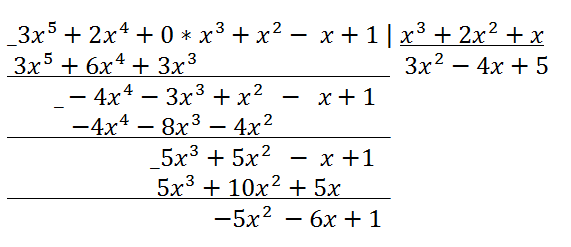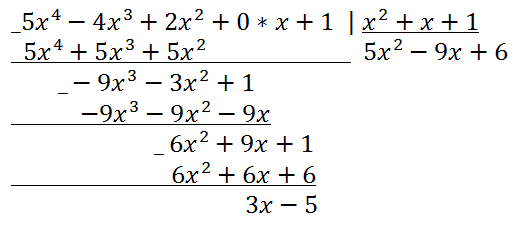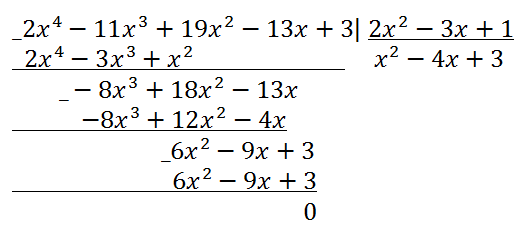Dividing a polynomial by a polynomial with a remainder
Example 1.
Divide the polynomial 3x
5 + 2x
4 + x
2 - x + 1 by the polynomial x
3 + 2x
2 + x.
Answer.
Let's describe the algorithm for dividing polynomials for this example in steps.
1. Let's write down both polynomials in descending order of degrees
3x
5 + 2x
4 + x
2 - x + 1 = 3x
5 + 2x
4 + 0*x
3 + x
2 - x + 1,
x
3 + 2x
2 + x = x
3 + 2x
2 + x
2. We divide 3x
5 by the first term of the dividend x
3. We get the first member of the quotient 3x
2.
3. We multiply the first term of the quotient 3x
2 by the divisor x
3 + 2x
2 + x. We get a polynomial
3x
5 + 6x
4 + 3x
3 and write it under the dividend.
4. We subtract from the dividend 3x
5 + 2x
4 + 0*x
3 + x
2 - x + 1 the polynomial written under it. We get the first remainder -4x
4 - 3x
3 + x
2 - x + 1.
5. We divide the first term of the first remainder -4x
4 by the first term of the divisor x
3. We get the second term of the quotient -4x.
6. We multiply the second term of the quotient -4x by the divisor x
3+2x
2+x. We get the polynomial
-4x
4 - 8x
3 - 4x
2 and write it under the first remainder.
7. We subtract from the first remainder -4x
4 - 3x
3 + x
2 - x + 1 the polynomial written under it. We get the second remainder 5x
3 + 5x
2 - x + 1.
8. We divide the first term of the second remainder 5x
3 by the first term of the divisor x
3. We get the third term of the quotient 5.
9. We multiply the third term of the quotient 5 by the divisor x
3 + 2x
2 + x. We get the polynomial
5x
3 + 10x
2 + 5x and write it under the second remainder.
10. We subtract from the second remainder 5x
3 + 5x
2 - x + 1 the polynomial written under it. We get the third remainder
-5x
2 - 6x + 1.
11. The degree of the third remainder is less than the degree of the divisor, therefore the division process is complete. The quotient of division
3x
2 - 4x + 5, the remainder -5x
2 - 6x + 1.
Let's write the division of polynomials as a "corner" division.
 Answer:
Answer: 3x
5 + 2x
4 + x
2 - x + 1 = (3x
2 - 4x + 5)*(x
3 + 2x
2 + x) - 5x
2 - 6x + 1.
Example 2.
Divide the polynomial 5x
4 - 4x
3 + 2x
2 + 1 by the polynomial x
2 + x + 1.
Solution.
Dividing a polynomial by a polynomial by a column (corner)
 Answer:
Answer: 5x
4 - 4x
3 + 2x
2 + 1 = (5x
2 - 9x + 6)*(x
2 + x + 1) + 3x - 5.
Dividing a polynomial by a polynomial without remainder
Example 3.
Divide the polynomial 2x
4 - 11x
3 + 19x
2 - 13x + 3 by the polynomial 2x
2 - 3x + 1.
Solution.
Dividing a polynomial by a polynomial by a column (corner)

The polynomial 2x
4-11x
3+19x
2-13x+3 is the dividend by the polynomial 2x
2 - 3x + 1 with no remainder.
Answer: 2x
4 - 11x
3 + 19x
2 - 13x + 3 = (x
2 - 4x + 3)*(2x
2 - 3x + 1).


